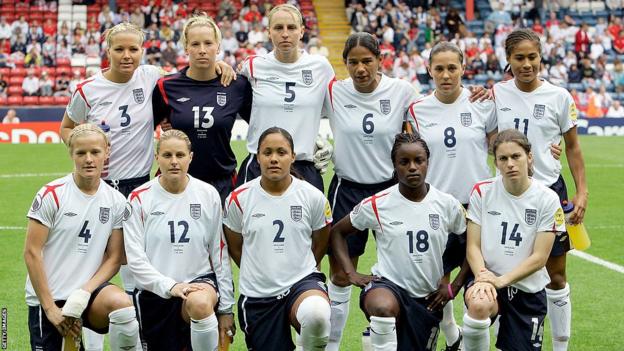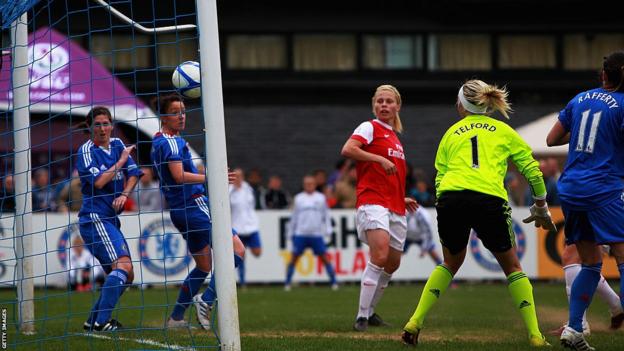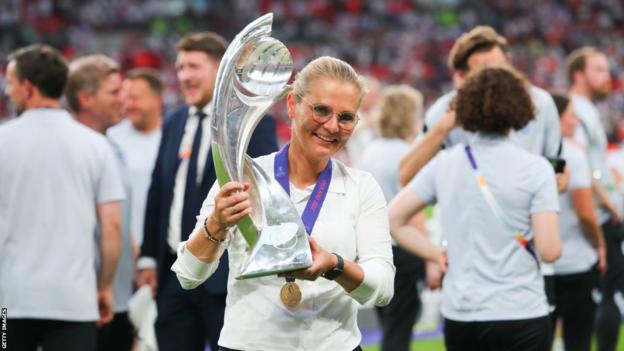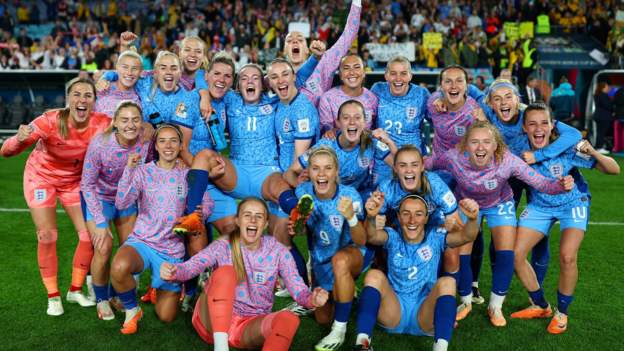Anyone over 53 today lived in a time when women were forbidden to play football in England.
It’s a fact that, given the context of this history-making weekend, it’s almost laughable.
A statement issued by the Football Association in 1921 announcing the ban, which would last for nearly 50 years, said: “The game of football is totally unsuitable for females and should not be encouraged.”
Another half century later, the story tells of a significantly different time. European champions England are already standing on the cusp of global glory as the Women’s World Cup final against Spain approaches on Sunday.
How did we get here then?
Teenager turned major
It might seem odd to start in 1966, the year England won the Men’s World Cup, but a young Patricia Gregory was watching that match on TV.
Thrilled, and Tottenham winning the FA Cup the following year, the 19-year-old wondered why women couldn’t play the game as well.
She put a notice in her local newspaper to request players and was inundated with responses, but the board said she could not legally rent a stadium for matches against other women’s soccer teams.
Gregory eventually succeeded in getting on the pitch and ended up managing both the Women’s Football League, as well as founding the Women’s Football Association as the game’s governing body in 1969 – the year before the FA rescinded its ban on women.
Hope and Change in the Nineties

In 1972, England’s first official women’s team played an international match – beating Scotland 3-2 – but it would be another 26 years until a full-time coach was appointed to the post. Enter Hope Powell.
The 1990s brought many firsts in women’s soccer. In England, the Centers for Excellence, the National League One, and the women’s game were brought under the control of the FA. Globally, the 1990s brought the first official Women’s World Cup tournament.
But when Powell took charge of England in 1998, it marked the beginning of a 15-year reign during which she led England to two World Cups and four European Championships, and cemented her position as the pioneers of women’s football in the country, playing a large part in the success we see today.
The house of the first euro
The Women’s Euro came to England for the first time in 2005, played in Blackburn, Blackpool, Manchester, Preston and Warrington, while Germany lifted the trophy at Ewood Park.
It was a tournament that offered a glimpse into the future. Fans sporting replica jerseys with players’ names on the back flocked to the matches, with an average attendance of 23,160 accompanied by the more than two million people who follow England matches on the BBC. Yes, interest waned after the Powells failed to make it out of their group, but it was the beginning.
But after the tournament, then-UEFA president Lennart Johansson sparked an angry reaction when he said women’s football sponsors could benefit. Enhance the physical attributes of players. “Companies can benefit from a nice-looking, sweaty girl playing on the ground in rainy weather,” he said.
Much still needs to change.

England’s First Decades
Four years later, there was another step in the right direction. Seventeen players, including Casey Stoney, Steve Hutton, Jill Scott and Rachel Yankee, were Central contract awarding by the FA, each receiving salaries of £16,000.
These contracts, which lasted four years, took the pressure off those players who needed work outside of football – although they could still work up to 24 hours a week – and required them to be available for all training camps, matches and tournaments, So are personal appearances.
At the time, Powell said: “We hope this will allow our girls time to focus on helping England qualify for the major tournaments on a consistent basis and compete at the highest level against the best teams in the world.”
The start of the Women’s Super League
2011 saw the launch of the Women’s Premier League, which comprises eight semi-professional teams who have received licenses from The Football Association after meeting strict criteria.
Clubs were given £70,000 from the FA for each of the first two seasons – to be spent on infrastructure – and a salary cap was subscribed, meaning no more than four players per side could be paid more than £20,000 in a bid. To ensure star players are distributed fairly across teams.
The opening match, played at Tooting and Mitcham at Imperial Fields in South London, saw the opening match Arsenal beat Chelsea 1-0 In front of about 2,500 paying fans, though, a swaying pitch caused problems for both sides.
Poor stadium standards – where have we heard that before?

Hello Wembley
Wembley Stadium. Football house. Well, men’s football – until 2014, when England played their first international match in the new Wembley in a friendly match against Germany.
Mark Sampson’s team lost 3-0, It was watched by a then England record crowd of 45,619. This figure should have been higher, given all 55,000 tickets were sold, but nearly 10,000 fans did not turn up due to London transport problems and the weather.
In 2019, their next appearance at the National Stadium which also ended in defeat to the Germans, was 77,768 people in the crowd, but that number rose to 87,192 by 2022, when England got their revenge on Germany in the European Championship final.
More on that later.
Mark Sampson dispute
Sampson was England coach from 2013 until his sacking in 2017, and led the Lionesses to a third-place finish at the 2015 Women’s World Cup.
But it’s long, messy dispute It resulted in two of his England players, Eniola Aluko and Drew Spence, eventually receiving an apology from the FA for Sampson’s racially discriminatory remarks, after an independent lawyer ruled he had made “ill-advised attempts at humour” on two occasions.
Sampson was actually fired over protection issues after evidence emerged of “inappropriate and unacceptable” behavior with female players in a previous role. Subsequently, he filed an unfair dismissal case against the Football Association, which was settled “confidentially” in 2019.
At the time, the FA came under fire for its handling of the Sampson case, and at a Digital, Culture, Media and Sport Committee hearing in 2017, questions were raised about the management’s culture around the England team and the FA’s duty of care. towards its women’s team.
WSL turns professional
The summer of 2018 saw a big change for the World Series of Poker. Transition to full-time professional status With the restructuring of an 11-team league.
The FA have introduced new licensing standards for clubs, meaning all teams have to re-apply for their places, with the requirement that they provide at least 16 contact hours per week for players and the academy.
In 2022, a BBC analysis suggested the average WSL player now He earns £47,000 annuallyAnd after the success of the tournaments in the European Championships, the attendance of the WSL League increased by 267%, supported by the large matches held in the largest stadiums in the country, including Old Trafford, Emirates Stadium, Anfield and Tottenham Hotspur Stadium.
Wegmann and the euro

Former Manchester United player Phil Neville was appointed in January 2018, despite having no previous experience in the women’s game. He won the SheBelieves Cup in 2019 and England finished fourth in that year’s World Cup in France.
But an ensuing slump in results, with seven defeats in their last 11 games amid disruptions to some matches due to the Covid pandemic, has left Neville’s record and England’s development in question – especially against the best sides.
When he left for Inter Miami in January 2021, six months before his contract expired, Baroness Sue Campbell, the FA’s director of women’s football, hailed his “huge contribution” to raising the “profile” and “defending” of the women’s game. .
But when the Football Association announced Sarina Wiegmann would succeed Neville as England coach in September 2021, they knew they would bring in a ‘proven winner’.
Having led the Netherlands to the European title in 2017, and the World Cup final two years later, she has a proven track record of “building a winning team”.
And it has also been proven. In their 38 matches, England have lost only once. Among their 30 victories, their biggest to date came just over 12 months ago, when the Lionesses made history by winning Euro 2022, the first major trophy that propelled many players into household name status.
Sunday’s win, in the tournament’s first World Cup final, would be even bigger.
World Cup champions?
And so on to that final.
On Sunday, the Lionesses had a golden opportunity to become the first major English team to win the World Cup since 1966, the year women like them were banned from the sport.
Maybe, maybe, soccer is female-appropriate after all.
